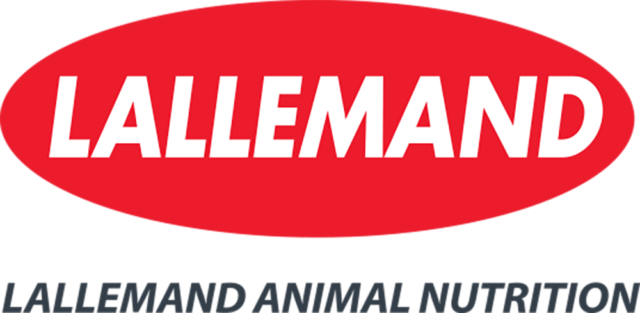Cereal crops are best known as primary ingredients for flour and beverages like beer. However, they are also an important source of nutrients for livestock. Large volumes of high-quality feed can be produced within short periods, allowing double-cropping and reducing the risk of adverse weather conditions during late stages of growth.
The most widely grown small-grains crops – wheat, triticale, oats, rye and barley – are of particular interest for ensiling due to their high content of soluble sugars and low buffering capacity. Therefore, small-grain silages are receiving special attention due to greater demand for forage inventories. Small grains also are easy to establish and can be grown in a wide range of climatic and soil conditions.
This is the first in a two-part series on ensiling small-grains crops and how to feed them. This article also summarizes topics in several talks at the recent “Silage for Beef” event organized by the University of Nebraska, Iowa State University and Lallemand Animal Nutrition. To download the complete proceedings of these presentations, go online (beef.unl.edu/2022-silage-beef-cattle-conference).
Wheat
Wheat is an “all-purpose” crop. It’s great for pasture, silage and hay. The crop is also late-maturing, which makes adequate amounts of high-quality forage, but the amounts of early growth and total forage yield are below average for small grains. Wheat is tolerant of wet, clay soil areas but sensitive to a pH less than 5.5.
Oats
Oats produce more forage in a shorter time than any small grain. However, it’s the least winter-hardy. (Fall-planted crops risk winterkill.) It is often grown in combination with other small grains (wheat or rye) or legumes like peas and maybe vetch – although photosensitivity may be a problem. Harvest timing should be based on maturity of the small-grain component since the legume has slower decline in nutrient quality.
Cereal rye
Winter cereal rye is cold-tolerant and has the earliest maturity of the small grains. It is normally planted if it gets too late in the season for triticale. Cereal rye excels in sandy soil and produces more total forage than wheat.
Triticale
Triticale is a cross-breeding result between rye and wheat, aiming to combine the grain quality and productivity of wheat with the disease resistance, vigor and hardiness of the rye. It includes lodging resistance, high protein content, a long growing period and a wide harvest window. It may be considered a “low-input” crop since it is adapted to challenging situations (acidic soil and drought conditions, for instance).
Barley
Barley is a high-tillering crop and popular in western Canada and the northern U.S. as substitute for corn silage since it also has the greatest grain-to-forage ratio at later stages of maturity. It matures earlier and is more susceptible to winterkill than wheat. Barley is also tolerant of soils with high salinity, and it does best on fertile, well-drained soils.
Cultivar selection can be as critical as the species you are planning on growing. Although the overall management for different cereal crops is similar, there is a wide range in terms of yield, nutrient composition and digestibility, traits and adaptability to a specific region. Unsurprisingly, what works in one region may not work in others.
Harvesting small grains for forage
It is well established that plant growth and maturity bring more yield but decreased quality (Figure 1).
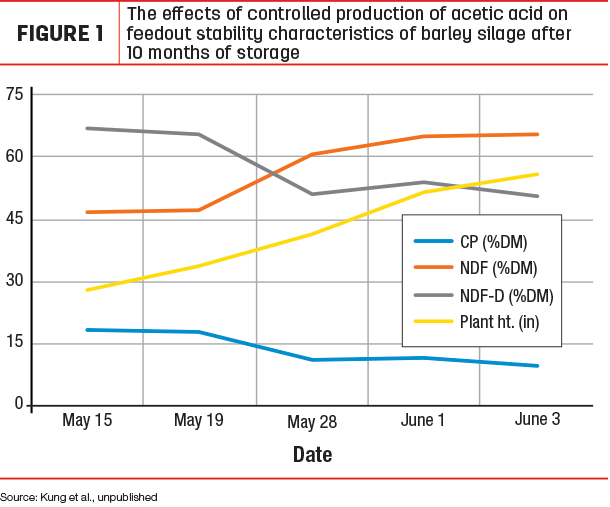
According to Dr. Matt Akins, researcher at the University of Wisconsin, small grains should be harvested at the boot stage for best quality (15% to 20% crude protein, greater than 65% total digestible nutrients), wilted to 35% to 40% dry matter (DM) and fed to lactating cows and young heifers. It can also be direct-cut and ensiled at the heading to soft dough stage (12% to 15% crude protein, 55% to 65% total digestible nutrients) for other cow groups such as dry cows and more-than-1-year-old heifers. It is advisable to monitor the field closely, since these cereal crops advance very quickly from vegetative (boot) to reproductive (dough) stages.
At 35% DM, 5 to 7 tons per acre should be expected at boot stage and between 8 to 10 tons per acre at dough stage. It is important to remember: The level of crude protein (CP) declines with maturity as percentage of DM. In terms of pounds of CP per acre, this measure remains constant due to higher yield. Still, one must have in mind that ensiling at early maturity requires wilting – i.e., more wheel traffic, higher fuel and labor costs, and potential for soil contamination. In contrast, harvesting at later stages limits the options for double-cropping.
Small-grain forage ensiling tips
Ensiling small grains follows the same basic requirements: anaerobic conditions, proper moisture and simple sugars for fermentation led by competent lactic acid bacteria.
Anaerobic conditions, i.e., packing density, will set the stage for the anaerobic fermentation to occur – so pack tight, continuously and cover immediately. Ensiling outside the desired moisture content (60% to 65%) leads to different challenges and high variability (Figure 2).
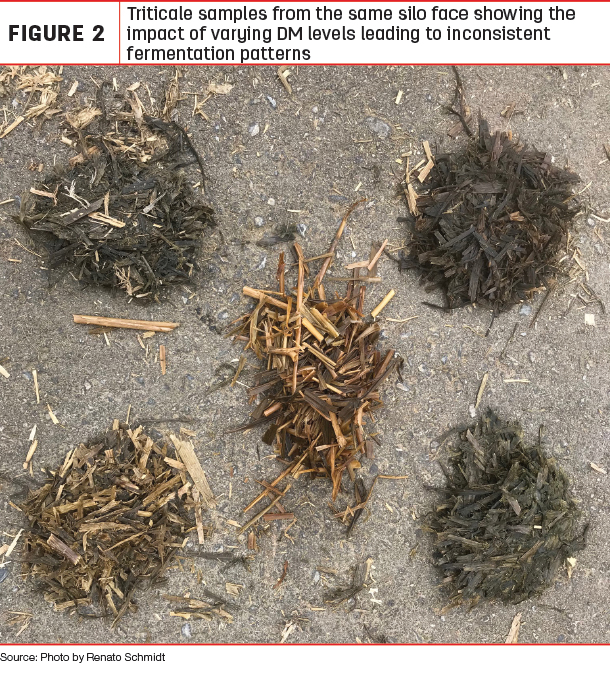
Excess moisture leads to extensive fermentation, high acid load and protein breakdown. In addition, excess moisture can encourage the development of clostridia and seepage. Drier forages are more difficult to pack due to their high porosity, allowing plant respiration and production of heat, mold and maybe mycotoxin production, and protein damage.
Make even good fermentation better
According to the late Dr. Keith Bolsen, emeritus professor at Kansas State University, “Every load of forage must be inoculated.” The use of a homolactic microbial inoculant for an efficient fermentation is already a worthy investment. Besides, it can help inhibit undesirable microbes, and certain formulations contain enzymes that help secure the minimal concentration of simple sugars for a successful fermentation.
Emeritus professor at the University of Wisconsin Dr. Richard Muck also told me one day that “You can always make a good fermentation better; you can always save on DM.”
A high application rate of L. buchneri forage inoculant targets feedout stability and helps maintain good hygienic conditions in silage through the conversion of moderate amounts of lactic to acetic acid, which has strong antifungal proprieties. This is an important and specific process: The natural production of acetic acid from a “‘wild” fermentation leads to higher losses and without the expected results in aerobic stability (Table 1).
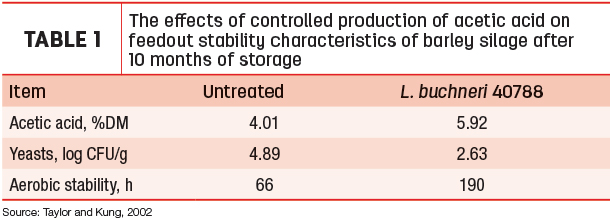
The catch: Packing
Packing small grains, especially if mature, can be a challenge due to their hollow (Figure 3), air-filled stems that may result in high volumes and porosity.
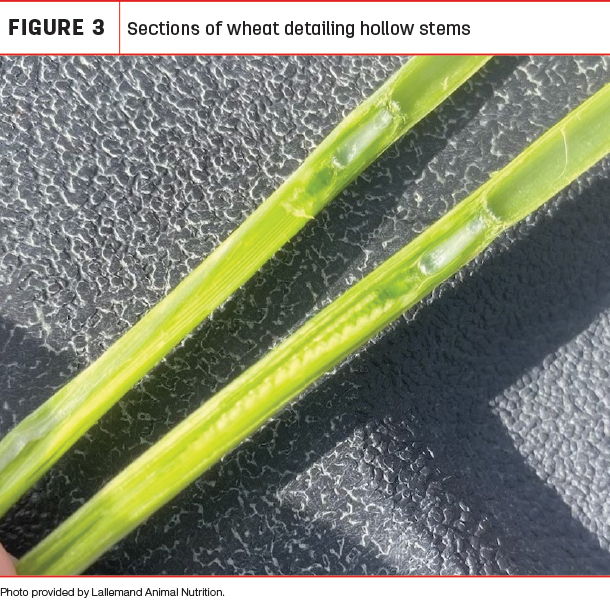
It is then recommended to chop finer as a result, between 1/4 to 3/8 of an inch, to achieve the desired fresh packing density of at least 45 pounds per cubic foot.
Lower temperatures, cloudy and/or calm days (no wind) will impact the drying rate and quality of the plant, so wide swathing can be advantageous.
The risk of soil contamination during drying is high, which can pose more challenges during ensiling. The presence of soil will delay fermentation by increasing the resistance of pH drop. In addition, soil can harbor many undesirable microorganisms.
Small grains may also have elevated nitrate content, especially in stressed conditions such as drought, frost and/or hail. Of course, this content also depends on the N fertilization program and weather (such as cloudy, cool conditions). The ensiling process can reduce the content of nitrates by around 40%, but sending a representative sample to a laboratory for testing is the best way to determine if there is a problem or not.
Getting the best results
Keep in mind: You will get the best results by harvesting the forage at the targeted stage of maturity and within the optimal DM range, and it is vital to manage well all the steps of ensiling:
- Follow the recommendations for particle length.
- Use a research-proven inoculant according to your needs and challenges.
- Pack tight with adequate weight, in thin layers and as progressive wedges, continuously.
- Cover as soon as possible, adding more weights over the seams and edges of the plastic.
- Monitor the integrity of the plastic during storage.
Small-grains crops can be successfully ensiled by understanding their features and following the recommended ensiling practices. They can increase forage inventory and add flexibility to a traditional silage crop program and help achieve your production objectives.


